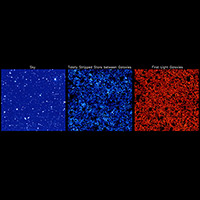Astronomers at the University of California at Irvine (UCI) and the Space Telescope Science Institute have made the most accurate statistical estimate of the number of faint, small galaxies that existed only 500 million years after the big bang. This was culled from an analysis of the deepest Hubble Space Telescope sky survey, CANDELS (Cosmic Assembly Near-Infrared Deep Extragalactic Legacy Survey).

Previously, studies using Caltech's CIBER (the Cosmic Infrared Background Experiment) rocket-borne instrument and NASA's Spitzer Space Telescope images confirmed the presence of "intra-halo light" from stars distributed outside of galaxies. The Hubble data found a new component in the infrared background in addition to intra-halo light — the collective glow of entire galaxies that formed first in the universe. UCI's Asantha Cooray believes that these early galaxies are very different from the well-defined spiral and disk-shaped galaxies seen in the present-day universe. They were more diffuse and populated by giant stars. This discovery paves the way for NASA's James Webb Space Telescope to see these very faint galaxies individually, after its launch in 2018.
For more information about this study,visit the story at
http://hubblesite.org/newscenter/archive/releases/2015/34/